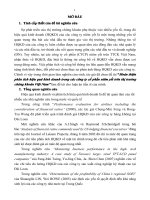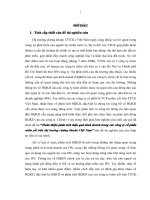tóm tắt tiếng anh hoàn thiện hệ thống chỉ tiêu phân tích tài chính trong các công ty cổ phần niêm yết trên thị trường chứng khoán việt nam
Bạn đang xem bản rút gọn của tài liệu. Xem và tải ngay bản đầy đủ của tài liệu tại đây (227.31 KB, 12 trang )
1
ABSTRACT
Vietnam’s economy is changing to market economy. Institutions in general
as well as accounting and financial institutions in particular are not strong enough
to build up an effectively financial foundation with authentic and explicit
information. The number of listed enterprises in stock market has just increased in
years. Information disclosure, especially financial information is still relatively
poor and not fairly positive. Completing financial analysis indicator system at the
beginning will lead the market in the right way, eliminating risks for relevant
subjects and the whole economy. This contributes to establish modern and global
market integration for the national finance.
After a period of researching, aimed to roles, objective and subjective
demands related to financial analysis indicators, I determined to choose the topic
for my PhD dissertation as “Completing the financial analysis indicator system in
listed companies in Vietnam securities market”.
Research targets of this thesis are problems of corporate finance, corporate
finance analysis, system of corporate finance analysis criteria and real situation as
well as opinions of completing financial analysis indicator system within listed
firms in Vietnam’s stock market.
Scope of this thesis is limited within non-financial listed joint stock
companies in Vietnam’s stock market. Real illustrated data was taken in some
fields as real estate, pharmacy and food processing.
Results of the thesis concentrated on solving problems below:
- Systemization of basic theories about financial analysis indicator system in
enterprises in general and listed joint stock companies in particular.
- Establishment of content, method and financial indicator within listed joint
stock companies in Vietnam securities market.
- Dramatic analysis and practicing evaluation of financial analysis indicator in
listed joint stock companies in Vietnam securities market, followed by offering
solutions to complete those.
2
Thesis structure:
“Completing financial analysis indicator system within listed companies in
Vietnam securities market”. Apart from introduction, conclusion, author’s project
list, references and bibliography, this thesis includes three main chapters:
Chapter 1: Theoretical framework about financial analysis indicators system
within listed firms in stock market
Chapter 2: Facts of financial analysis indicators system within listed firms in
Vietnam’s stock market
Chapter 3: Personal opinions and solutions for completing financial analysis
indicators system within listed firms in Vietnam’s stock market
CHAPTER 1
THEORETICAL FRAMEWORK ABOUT FINANCIAL INDICATOR
SYSTEM WITHIN LISTED COMPANIES IN SECURITIES MARKET
1.1 Financial analysis and indicator system of corporate finance
1.1.1 Corporate finance and corporate finance analysis
1.1.1.1 Corporate Finance
According to this thesis, to approach and access the core issues of corporate
finance with the aim to practice corporate finance effectively, corporate finance
viewpoint does not only expose the internal relationships, but more importantly
also needs to show outside under forms of financial circumstances, financial
structure, solvency by time, financial leverage, financial risks, financing stability,
effectiveness of business, etc. Therefore, the thesis determined that corporate
finance in essence is the monetary relationship related to acting and transferring
of financial resources; which creates value movement in business and makes
changes in financial structure of enterprises. Action and transfer of resources in
business creates differences in financial situations, financial structure, financial
risks, effectiveness or money-flows for each enterprise.
3
1.1.1.2 Corporate Finance Analysis
To perform informational function and management roles in an effective way,
finance analysis content needs to include general evaluation of financial situation;
financial structure and capital assurance analysis for business activities; solvency
analysis; operation capacity analysis; profitability and growth analysis; financial
risk analysis and financing forecast.
1.1.2 Analysis indicator system of corporate finance
1.1.2.1 Establishment principles of analysis indicator system of corporate
finance
1.1.2.2 Viewpoint in analysis indicator system of corporate finance
Financial analysis indicators system needs to be divided into two types to
maximize its functions in management as indicators for general finance analysis
and for deep finance analysis
In details, the dissertation considers that indicators for general finance analysis
consists of indicators which evaluating capital mobilization, financial
independence level, solvency and profitability.
1.1.2.3 Indicator system in general financial analysis
General evaluating of financial situation of firms guarantees at least in aspects
including: capital mobilization, financial independence level, solvency and
profitability.
1.1.2.4 Indicator system in specialized financial analysis
Specialized and detailed financial information is used for significant and cautious
decisions; hence, specialized analysis is extensively necessary. As mentioned
above, indicators system in specialized financial analysis comprises criteria
reflecting financial structure, solvency by time, effectiveness of business, financial
risks analysis and financial forecast, and money-flow analysis indicator
1.2 Financial analysis indicator system for listed joint stock companies in
securities market
1.2.1 Characteristics of listed joint stock companies in securities market
4
1.2.2 Financial analysis indicator system for listed companies in some countries
1.3 Financial analysis indicator system for listed companies in some countries
1.3.1. Financial analysis indicator system for listed companies in China
1.3.2. Financial analysis indicator system for listed companies in Singapore
securities market
1.3.3. Regulations in Hong Kong securities market
1.3.4. Regulations in London Stock Exchange (LSE)
1.3.5. Regulations in American securities market
1.3.6. Lesson for Vietnam
Based on researches of financial analysis indicator system within some
listed joint stock companies in stock market in some countries, the lessons in
completing financial analysis indicator system in listed join stock companies in
Vietnam’s stock market are suggested as financial criteria are grouped clearly;
financial indicators have data supported by financial reports and accounting
management reports; there are financial analysis methods; the researched
countries have associations or organizations and especially the analysis
indicators of different industries are not the same.
CHAPTER 2
FACTS OF FINANCIAL INDICATOR SYSTEM FOR LISTED JOINT
STOCK COMPANIES IN VIETNAM SECURITIES MARKET
2.1 Overview of Vietnam securities market and listed joint stock companies in
Vietnam securities market
2.1.1 History of Vietnam securities market and listed joint stock companies
in Vietnam securities market
2.1.1.1Vietnam securities market
2.1.1.2 Listed joint stock companies in Vietnam securities market
2.1.2 Characteristics of listed joint stock companies in Vietnam securities
market
5
2.1.2.1 Facts of listed joint stock companies in Vietnam securities market
2.1.2.2 Characteristics of listed joint stock companies in Vietnam securities
market
Listed joint stock companies in Vietnam securities market that were almost found
by capitalization of state owned enterprises have just operated. Information
disclosure and explicitness of listed joint stock companies are still limited.
2.1.2.3 Classifications of listed joint stock companies in Vietnam securities
market
- Classification by time
- Classification by industry, business operating sector
- Classification by scale/charter capital
2.2 Current state of financial analysis indicator system in joint stock
companies in Vietnam securities market
2.2.1 Financial analysis indicator system in joint stock companies in Vietnam
securities market under law provision
Information disclosure about the financial circumstances in general and the
system of financial analysis indicators system of joint stock companies (JSC)
listed on Vietnam's stock market in particular, was launched along with the
securities laws No70/2006 / QH-11. Information about the financial situation was
announced at the time of initial public offering (IPO) and at the end of each fiscal
year, in addition to publication of the extraordinary when they arise. According to
Clause 1, Article 15 of the Securities Law, companies released financial
information for the first time in prospectuses.
A prospectus is a document or electronic data publishing accurate, honest,
objective information related to the securities offering or listing of an issuer.
According to Decision 13/2007/QD-BTC, the indicators system of financial
analysis of listed JSC including: Current ratio, Quick ratio , Debt / Total assets ,
Debt / Equity, Inventory turnover, Asset turnover, Return on Equity (ROE), Return
on Assets (ROA).
6
In annual reports, listed JSC describe the business activities during fiscal
year and present the results of them through financial statements (Balance sheet,
Profit & Loss, Cash-flow statement) with the interpretation (notes to financial
statements).
According to the Circular 09/2010/BTC dated January 15, 2010, listed JSC
announces the following information:
Periodical information: quarter and annual financial statements audited by
authorized institutions (Balance sheet, Profit & Loss Statement, Cash-flow
statement, Notes to financial statements comply with accounting law, in case of
notes to financial statement accompany with appendices, appendices must be
disclosed with notes to financial statement)
Abnormal information: listed JSC must disclose the following information as
soon as possible (24 hours or 72 hours) after the occurrence of any of the
following events: losing property valued 10% equity or more due to registration of
transactions, resolutions of the General Assembly of shareholders or board of
management related to increase or decrease of charter capital, capital contribution
valued at 10% or more of the total assets of the listed organization on another
organization; capital contribution valued at fifty percent (50%) or more of the total
capital of contributed company.
Required information: after receiving a request from the SSC or Stock Exchange,
through publications, official websites of listed organization, through mass media
or means of disclosure of the SSC, Stock Exchange.
Also, it needs to publish information on transactions of shareholders, who are
authorized to disclose information and major shareholders, on the last registration
exercise for existing shareholders, relevant information to corporate governance.
2.2.2 Current situation of financial analysis indicator system in joint stock
companies in Vietnam securities market
2.2.2.1 Financial analysis indicator system in joint stock companies in real-
estate industry
7
Currently, the total number of JSC in real estate filed listing on Vietnam's
stock market is 27. With 27 stock codes on different scales of capital, the smallest
capital is RCL (Cho Lon Real Estate JSC) with VND 29 billion and the largest one
is OGC (Ocean Group JSC ) with VND 2,500 billion. For a group of companies
which have over 200 billion of capital in real estate industry, the thesis examined
Vincom Corporation (stock code: VIC, capital: VND 1,996,272,380,000), Thu
Duc Housing Development JSC (stock code: TDH, capital: VND
378,750,000,000), Kinh Bac City Development Holding Corporation (stock code:
KBC, capital: 1,991,243,300,000). For the rest (capital is under VND 200 billion),
the thesis analyzed Tu Liem Urban Development JSC (stock code: NTL, capital:
VND164, 000,000,000), Ba Ria-Vung Tau Housing Development JSC ( stock
code: HDC , capital: VND 81,280,000,000), Construction JSC No.3 – Vinaconex
3 (stock code:VC3, capital: VND70,960,200,000).
In the stock codes VIC, KBC, TDH, indicators of financial analysis used include:
- Indicators reflecting assets structure is ratios which show the proportion of each
asset in total property. Thereby, managers assess the reasonableness of allocating
assets. Assets structure is examined in general, between short-term and long-term
assets without analyzing each part of the above property in detail. To reflect the
assets structure, some companies in this sector using the following two criteria:
Current asset over total asset indicator, with following formula:
Current Asset * 100 Current
Asstes/Total
Assets
=
Total Asset
With the above criteria, how much the value of current assets accounts for in total
assets, current assets structure is consistent with the characteristics of each
company.
8
Non-current asset over total asset indicator, with following formula:
Non-current Assets *
100
Non-Current
Assets/Total
Asset
=
Total Asset
With the above criteria, how much the value of non-current assets accounts for in
total assets, non-current assets structure is consistent with the characteristics of
each company. Through the survey, VIC was the only one which announced these
two indicators with figures in 2008, 2009.
- Indicators reflecting the capital structure (debt on equity ratio)
- Indicators reflecting solvency.
- Indicators reflecting profitability (net profit after tax / gross profit / net profit
before tax)
Financial analysis indicators of stocks NTL, VC3, HDC are as the following:
Financial criteria, basically, are divided into four groups, including: asset
structure, capital structure, solvency, profitability. In these groups, there are some
differences in calculating in each firm. For examples, in the capital structure
indicators, instead of using “liabilities / total equity”, HDC identified two criteria:
“liabilities / owners’ equity" and "advances from customers/ equity". For
profitability, besides profit margin on sales, profit margins on equity, few
companies use profit margin on capital ratio as well.
2.2.2.2 Financial analysis indicators system of listed joint stock companies food
manufacturing and processing
2.2.2.3 Financial analysis indicators system of listed joint stock companies in
pharmaceutical industry
Unlike industries mentioned above, financial analysis indicators system in the
pharmaceutical industry is quite plentiful reflecting different aspects such as
capital structure, financial risk, and solvency, profitability, and operation profit
and growth indicator.
9
2.3 Evaluating current situation of financial analysis indicators system of
joint stock companies listed in Vietnam securities market
2.3.1 The reflection range
Financial analysis indicators announced by listed JSC are criteria reflecting assets
structure, capital structure, solvency, profitability; however, it has not actually
completed. Executives need information on capital using policy, Thus, the
previous financial analysis indicators have not shown the effectiveness of listed
firms. Specifically, for each group of listed JSC in the above sectors as the
following:
Real estate industry: Financial analysis indicators system is classified into four
groups: indicators of asset structure, capital structure, solvency and profitability.
Thereby, we could collect information on the using assets, capital mobilization
policies, solvency and profitability of businesses. Indicators in the same group of
indicators is different between stock codes, such as group of indicators reflecting
capital structure; indicators of solvency or profitability indicators of VIC, KBC,
TDH; and NTL, VC3, HDC.
Food manufacturing and processing: Financial analysis indicators system is
classified into four groups: indicators of asset structure, capital structure, solvency
and profitability. Thereby, we could collect information on the using assets, capital
mobilization policies, solvency and profitability of businesses. Indicators in the
same group of indicators is different between stock codes, such as group of
indicators reflecting capital structure; indicators of solvency or profitability
indicators of AAM, VNM, ANV; and HHC, VDL, NGC.
Pharmaceutical industry: Financial analysis indicators system in this sector is
very different. Stock code DHG, TRA, MKV and OPC provide same financial
criteria about asset structure, capital structure, solvency and profitability. These
financial criteria described each aspect of corporate finance in detail through
indicators systems of DMC and DCL. Thereby, we could collect information on
10
the using assets, capital mobilization policies, solvency and profitability of
businesses operational capacity and growth of companies.
2.3.2 Quantity, names and calculating methods of indicators in each group
Through the survey, names as well as calculating methods of financial indicators
are inconsistent; therefore, comparisons of financial information among
companies in each sector could not be implemented. Specifically, names of some
indicators are not appropriate to the current accounting regime, for examples:
stock DMC, DCL, VDL using current assets and fixed assets. Name of the
indicators are inconsistent, such as criteria reflecting the profitability of NTL,
VC3, HDC. There are also the same indicators but different calculating methods.
Tow indicators: Liabilities / total assets and liabilities / total capital are used to
reflect the structure of capital of stock VIC, KBC and TDH; or, greater differences
are from calculating angles of stocks NTL, VC3 and HDC for capital structure
criteria. Besides, calculations of indicators are not exhaustive, such as stock VC3
publishing profit after tax on capital ratio.
2.3.3 Disclosure of financial analysis indicators
The publication of financial analysis indicators is compulsory information in
prospectuses and annual reports. However, in reality, some companies announced
them and some did not. Indicators have been not disclosure fully among listed
firms, such as stock NTL did not announce criteria reflecting the asset and capital
structures. In contrast, same financial indicators are published twice with different
names in the same group. Current ratio and liquidity ratio are names of the same
financial analysis criteria; however, they have been published simultaneously.
11
CHAPTER 3
POINT OF VIEW AND SOLUTION TO IMPROVE FINANCIAL
ANALYSIS INDICATOR SYSTEM IN LISTED JOINT STOCK
COMPANY IN VIETNAM SECURITIES MARKET
3.1 Point of view to improve financial analysis indicator system in listed joint
stock companies in Vietnam securities market
3.1.1 Financial analysis indicator system must be public and transparency to all
related objects
3.1.2 Financial analysis indicator system must be simple and straightforward
3.1.3 Financial analysis indicator system must be timely and objective
3.2 Solution to improve financial analysis indicator system in listed joint stock
companies in Vietnam securities market
3.2.1 Complete indicator system that analyzes general financial status of joint
stock companies listed in Vietnam securities market
3.2.1.1 Complete indicator system that generally analyzes general mobilization
status of stock companies listed in Vietnam security market
Capital mobilization status of listed company strongly affects to subjects
(shareholders, securities companies, potential investors) so scale of funding is an
important factor to financial health. Mobilization information of listed company is
expressed through following financial indicators: short-term liabilities, long-term
payable, owner equity, and total equity.
3.2.1.2 Complete indicator system that analyze the general degree of
independence
3.2.1.3 Complete indicator system that analyze general solvency ratio
Through conducting survey of financial indicator from financial analysis, solvency
ratio of: Real estate area - current ratio and short-term payable are different
names from the same formula so that security code: KBC and VC3 cannot use this
two benchmarks simultaneously. Manufacture and food processing - current ratio
and short-term solvency ratio are different names from the same formula so that
12
security code: AAM and HHC cannot use these two benchmarks simultaneously.
Pharmacy area - security codes in this group public different assessment
benchmarks, so to come up with agreement and data can be compatible, the best
solution is a united financial indicator system.
Liquidity ratio of listed company is financial capacity to ensure payment for loans
that having credit relationship with company. With executives, using financial
indicators to manage business process, ensure that company operates efficiently,
optimizes current capital and avoids losing solvency. This financial capacity exists
under monetary manner (cash, deposits ), account receivable from other
companies, assets can be transferred to cash quickly such as: goods, products,
consignment. Company’s debts can be loan from banks, account payable and
advance payment from buyer, postponed tax, unpaid salary. Liquidity of the asset
depends on how easy to transfer from asset to cash without big loss. Solvency
management is combination of payment requirement with payment deadline and
other cash sources to avoid losing solvency with technical cause. How to calculate
solvency is very important requirement because it expresses debt responsibility of
the company, so that using solvency ratio is considered as liquidity test for
company. Solvency indicator includes: total asset ratio, current ratio, quick ratio,
cash ratio, due debt ratio. Meaning and calculation of these ratios as following:
Total asset/Debt ratio, it has significant with total current asset of listed company.
At the period financial report has finished, total current asset can be paid for the
debts at that time. Total asset, liability items are taken from code 270 and 300 in
balance sheet.
Current ratio, measures value of short term assets (cash, inventory, account
receivable, short term investment, ) with short term debt which has to pay in
short accounting term. Short term asset, short term debt items are taken from code
100 and 310 in balance sheet.
13
Quick ratio, measures value of short term asset which deducted inventory, with
short term debt in accounting year. Short term asset, inventory, short term debt is
code 100, 140 and 310 in balance sheet
Cash ratio, measure quickly reaction for payment. Cash and cash equivalency,
short term debt is code 110 and 310 in balance sheet.
Quickly payment due debt ratio, shows that cash and cash equivalency can be paid
for due debt. Cash and cash equivalency are code 110 in the balance sheet. Due
debts are summarized from detail accounting customer debt, suppliers, and due
long-term debt
Due debt ratio shows emergent situation of payment carried out by cash and cash
equivalent of listed company. Cash and cash equivalency can be taken like above
index, total debts have requirement to pay debt includes due debt, or overdue debt
such as suppliers, other borrowing…
3.2.1.4 Complete indicator system that analyzes general return ratio
By real survey, group of indicator that reflects return ratio of joint-stock company
listed in Vietnam stock market still has some restrictions. A solution with real
estate area – agree with that indicators of ROE, ROA, ROS must use profit after
tax, instead of gross profit like KBC. Besides, we call above indicators are rate
instead of coefficient as VC3 does. Moreover, VC3 also calculate profit after tax
divides charted capital. Manufacture and food processing – come up with
formula of indicators that reflect ROE, ROA, and ROS. For example, VDL and
NGC need to standardize formula and names of those indicators, replace
coefficient with rate of return. At once, HHC need to use rate of return divide
equity than charted capital. Pharmacy area, listed companies in this group use
different benchmarks so that, to unite and compare the data, the necessary solution
is having a united financial benchmarks system.
Information of profitability of listed companies will affect to stock price strongly.
To have earliest information, according to the thesis, indicators that assess rate of
14
return of listed company by: return of asset (ROA), return on equity (ROE) and
return on sales (ROS).
3.2.2 Complete the intensive financial analysis indicator system
Indicator of financial analysis system in dept allows managers compare and
assess every activity and real situation in different period efficiently. More
importantly, they can understand causes affect to the performance of corporation.
With these benchmarks, thesis refers that there must have benchmarks of financial
analysis system enough to see all the problems from every activity of company.
These benchmarks must reflect financial structure of corporation, necessary of
capital, payment situation, payment schedule according corporation timeline,
efficient of operation, financial risk
3.2.3.1 Indicator system of analyzing financial structure
A survey of the status of indicator system of financial analysis of joint stock
companies listed on Vietnam's stock market, financial structure has been
mentioned through benchmarks of asset structure, capital structure. With
benchmarks that are not enough, its name is yet consistent with accounting
standard, thesis have some ideas for improving the surveyed industries as follows:
Real estate area - indicators of capital structure: agree with the formula for
calculating liabilities on capital rather than only debt divide total capital as stock
of the TDH, and (debt – advances payment from customer)/equity of the code
HDC. Manufacture and food processing - indicators of asset structure: current
accounting regime (Decision 15, 20/03/2006) changed name of current asset, fixed
asset to short term asset, long term asset, so VDL should change to be appropriate
with the system. Pharmacy area - company in this group have different
benchmarks, so to be uniform and data is compared, an important solution is that
these companies should have united benchmarks of financial analysis. Financial
structure is considered at asset structure aspect, capital structure and relationship
between asset and capital. Therefore, intensive analysis of financial structure is
deeply analyzing factors that form asset, capital and their relationship.
15
Analyzing asset structure of listed company: the appropriation of asset structure
is measured by proportion of each asset in total asset, detail of each proportion and
comparison between asset items. Where cash item and cash equivalency are from
code: 110; short-term investment is from code: 120; short term receivable is from
code: 130; inventory is from code: 140; other short term asset is from code: 150;
long term receivable is from code: 211; fixed asset is from code: 220; investment
real estate is from code: 250; long term asset is from code: 260; in the balance
sheet. With detail of each item, company’s long term asset gives information of
suitable capital structure for each type of company. For example: real estate area,
proportion of real estate in total asset is much more than others; pharmacy,
inventory accounts for higher proportion. Indicators analyzing asset is used for all
the listed companies, however, real data of these companies of different area will
have its own financial situation.
Analyzing capital structure of listed company: the same as analyzing asset
structure, the efficient and optimization in mobilizing is showed by propotion of
each detail item in total capital. Where liability is from code: 300; short term
liability is from code: 310; short term debt is from code: 311; long term liability is
from code: 330; long term debt is from code: 334; equity is from code: 400;
retained earning is from code: 420; other fund is from code 430 in the balance
sheet.
Analyzing capital structure according to each item to provide detail information
about type of capital which how much it is raised and propotion in capital.
Companies will have the capital structure reflect the mobilization strategies of
their own. But the actual situation survey of listed companies in each industry has
its own characteristics. For example, real estate, liabilities proportion account for
bigger proportion, especially long-term loans, whiles the pharmaceutical industry
and manufacturing and food processing, the proportion of equity proportion is
bigger. Besides the capital structure of joint stock companies listed on the stock
market at different cycles of the market, the capital structure changes.
16
Analyzing the relationship of assets and capital: Sustainable financial structure
is not only represented by assets structure and capital structure but also the
relationship between asset and capital. The relationship between asset and capital
is expressed through the correlation of factor of liabilities with assets, of assets
with equity, reflecting the names, formulas and methods of analysis on above
relationship. The indicators include: Short-term debt ratio against asset, long-term
debt ratio against assets, the debt ratio compared to assets.
3.2.3.2 Indicator system of analyzing financial leverage
Financial leverage is the concept used to reflect and further analysis of capital
structure - an important method of the financial structure. When analyzing
financial leverage, analysts focus more on the relationship between financial
leverage and performance of listed companies through indicators reflecting
effective of using equity. Thereby, we can identify a suitable and optimal capital
structure for business. We will analysis financial leverage by contents: Analysis of
fluctuation in financial leverage, analysis of the relationship between financial
leverage and effective using of equity, analysis the sensitivity of financial leverage
and the relationship with business leverage.
3.2.3.3 Indicator system analyzes financial balance to ensure funding
To obtain information about funds for operation, company is not falling into the
financial imbalances, analysts often use following criteria: net working capital,
coefficient of regular funds, coefficient of temporary funds, coefficient of equity
against regular fund.
3.2.3.4 Indicator system for analyzing financial risk
Financial risks associated with financial activities and the level of using debt of
listed company. That is the risk that the owner incurred by using debts. Therefore,
when considering the financial risks, analysts generally consider risk of settlement
debt and the effect of debt structure to the profitability of listed companies.
Content financial risk analysis includes: Risk analysis for debt payment,
Correlation between financial risk and business performance.
17
3.2.3.5 Indicator system for analyzing payment
For general information about the solvency of listed company which is mentioned
above, thesis deeply analysis of financial indicators to provide information on the
status of payments to suppliers, debt collection situation from the customer at
specific time, and how long for payment.
Criteria for evaluating payment situation reflects the amounts that companies
take appropriate capital of the creditors (lenders can be suppliers, employees,
government, the internal unit, banks, credit institutions ) and appropriated by the
debtor (the debtor may be customers, affiliates, government,). There are 2
coefficients between debts receivable against payable. Which items of accounts
receivable, accounts payable are taken from the code: 131, 211 and 300 in the
balance sheet.
Indicator of the short-term payments analysis, similar to other benchmarks which
reflect general payment, indicators reflect the degree to appropriate capital or be
appropriated by suppliers or customers in a short time (this can be 1 month,
quarter, less than one year). Items in the formula are retrieved from monthly,
quarterly financial reports or detail receivable and payable in the ledger of listed
company.
Benchmark of the long term payment analysis, to evaluate in medium term and
long term of appropriate capital in bussiness of companies and their partners.
Detail coefficient is displayed in payment analysis sittuation table. Iterms in the
formula are retrieved from yearly financial report where has detail receivable and
payable of listed company.
Speed of payment analysis, payment on right time so speed of payment is good,
and vice verse. Because of information about speed of payment of listed company
is very important, it measures cycles of receivable, payable and time to recover the
debt and aslo payment. For detail: Evaluate speed of general payment, speed of
short term payment, speed of long term payment,
18
3.2.3.6 Indicator system for payment analysis according to timeline
It is necessary to balance between payment in timeline (monthly, quarterly, yearly,
or longer) and items which can be used to pay to have good financial situation.
With the target like this, coefficient of payment in timeline is calculated in each
detail period in present and future. However, calculation of this coefficient with
high confident value compare to real financial status of listed company is depend
on accurate and timely data. For detail of items used to pay in next month, quarter,
year are: cash and cash equivalency, short term financial investment, debt
receivable in the future, inventory, And items which have to pay according to
timeline such as: overdue debt (tax for goverment, short term loans, short term
liability, suppliers’ debts, ); due debt; debts have to pay in next month, quarter,
year.
3.2.3.7 Indicator system of analyzing business performance
The last criteria that managers, investors notice when analyze company’s finance
is the return on equity. However, this indicator is the combination of many factors.
There are some unexpected cases that hiden after “superficial glamour” of return
on equity are signature of go down in business operation. A carefull analysist is
not allow to ignore this sign. The thesis proposal that we should use the following
indicators: Performance using the residual value of fixed assets, efficiency of
major inputs.
3.3 Condition to implement solution for the financial analysis indicator
system in listed joint stock company in Vietnam security market
3.3.1 Listed joint stock company in Vietnam security market
In general, in long term, success or failure of a financial analysis
indicator system largely depends on listed joint stock companies, and comes from
their awareness about such issue. In term of market beginning, there are a huge
number of companies attracted by short-term benefits, which present through
disclosing information, analyzing or public information in a simple manner not
19
compliance with standard. Such companies have not yet indentified the degree of
important for stock value in long term in term of stability and increasing value, or
those of analysis information to access potential investor group and international
stock market. To complete those tasks, these companies should take initiative in
completing financial analysis indicator system, even should be based on the need
of investors, order SSC and other Security Exchange to build a public information
system properly (could be made through Associate). Things to do right for listed
companies are constantly retraining and improving knowledge, experience for
their staff to have a good human resoures in term of having enough capabilities in
handling with assigned tasks. Specifically, financial and accounting staffs must
meet the requirements: have a qualifications in accounting, auditing, finance, tax;
a deep understanding of Vietnam law, international and regional leading practices;
foreing language proficiency and computer skills; updating securities, tax,
accounting knowledge frequently; intensive knowledge of business operation.
Also listed companies need to satisfy the level of true and fair of data on financial
statement. Specifically, companies must hande well with following tasks:
recording economic transactions accurately; check the consistency of data when
calculating, move ledger, from entries to ledgers, from ledger to financial
statement; auditing before public information; followed by preparation of facilities
and equipment to work toward computerization.
3.3.2 Về phía Uỷ ban Chứng khoán Việt Nam
The State Securities Commission (SSC) as the decisive role to create, orient,
manage, monitor the development and operation of the stock market will play the
most important role to improve benchmarking system of financial analysis in the
listed company.
Firstly, about the perception, SSC should determine this is important, is the
foundation for a variety development goals for stock market such as: improving
the legal framework for consistency; set up mechanisms to monitor the stock
20
market maturely, professional under international rules to protect the legitimate
rights and interests of investors; increase transparency, "intelligent" investors;
ensure the stability of the stock market, building infrastructure with
synchronization of information technology and modernization; integrate with
capital market in the region and international;
Vietnam stock market is still in its infancy and SSC has too much work to do. It
should arrange the order of priority what need to do and can do. Improving
benchmarking system of financial analysis is one of the first things to do and can
do in advance: Vietnam’s accounting and auditing system is in the last leg of the
route in the direction of standardization consistent with the international standard
and the practical conditions of Vietnam. It means that foundation for to build up
benchmarking system of financial analysis has a relatively full. On the other hand,
the SSC can easily participate in this schedule while working as an agency under
the Ministry of Finance. A system of indicators with a complete analysis will
quickly raise the standard and quality of information published, contribute to
stable the market and attract quality investors (such as foreign investors,
investment organizations, ), increase integration capabilities. One of the cause,
that make SSC confuse in monitoring and modernizing information technology
systems before, (monitoring manually, there is no automatic information systems
to public and monitor the real-time) is the standardization of data. The
benchmarking system of financial analysis will be connection between modules
that participate in the stock market, as well as the stock market and capital
markets, and other financial markets.
Next, the SSC should have a roadmap to guide for using benchmarking system of
financial analysis. In the early period, the application of benchmarking system of
financial analysis is mandatory, enforced to use throughout the system. Then
application objects have to evaluate to find and get benefit from application of this
indicator system. For example, research and analysis institutions easily and
quickly have the assessment of the market, on each industry or each business
21
group and company; the issuer/listed company easily approach to the quality
investors without depending too much on consulting organizations or even
hanging public if ensuring that benchmarking system of financial analysis is
public as regulation; the multi-level activities monitor easily and smoothly through
synchronous system; investors feel less risky.
The application firstly should be started from the amendment and complete of the
regulations on information disclosure in stock market direction more closely. For
example, semi-annual financial statements (6 months) of a listed company must
have financial review of auditing company which is accepted. Semi-annual and
end year financial statements must have opinion of auditing company; every 6
months after the funding ends, the company must report to the SSC, the Stock
Exchange and published information on the website on the progress of capital use,
even if changing purpose of use capital. It must be disclosed reason of changing
the purpose and together with the resolutions of shareholders; the listed company
must have its own website, which must have the "Investor Relation" with updated
information fully and promptly. Together with that requirement is a specific
sanction, detailed and oriented more severe than the current regulations: fines,
rating information disclosure level, restricts the release of more document
securities
At the same time SSC should be empowered and stronger in handling with
companies listed on market. Finally, organization structure of SSC need to be
reformed: have an appropriate roadmap to separate SSC from Ministry of Finance;
segregation of duties, responsibilities of each division in SSC, ensuring no
overlap, particularly in supervision and enforcement. Gradually simplifying
administrative procedures in the direction of limiting the role of SSC in market
operation, increasing the role and responsibility of market participant: reducing
licensing issuance, acceptance, moving to registration regulation and reporting
activities; forming a specialized division in charge of restructure and
transformation (possibly under Market Development Agency); Building
22
infrastructure for modern information technology system with criteria,
international standards, uses to monitor the market by the SSC, ensure supervising
activities in real time and cover entire transaction of trading system on the Stock
Exchange; structure of the stock market in the direction of separating management
functions with the function of organizing and operating the market; the Stock
Exchange, Stock Coordination Center operate as the enterprise model to improve
management and operational capacity for these organizations as independent legal
entities. Building automatic system to disclose information to receive, synthesize
and analyze information from activities of market intermediaries, the issuers to
gradually develop and apply management mechanism according to risk.
3.3.3 Stock Exchange
Compliance with management funtion, and direct involvment in the
activities of stock exchange trading floor. Stock Exchange must frequently inspect
the compliance of listed companies.
23
CONCLUSION
To complete the financial indicator system for listed joint stock company in
Vietnam securities market is a critical requirement. Such compeletion must
comply with the strategy of securities market development toward 2020. Therefore
completing the financial indicator system for listed joint stock company must meet
those requirements: Ensuring financial analysis scientifically, clearly to meet the
demand for finanancial analysis of listed joint stock companies in particular, the
whole enterprises in general. Financial indicator system is classified in group
which have a high correspondence between each indicator group. Compliance
with accounting standard and law. Have a high level of academy, but easy to
apply, straightforward to proivde compelling and practical financial information.
Adapting to listed joint stock companies in Vietnam securities market. To clarify
the application of completed financial analysis indicator system, author has
conducted an analysis through published indicators in joint stock companies which
are listing in Vietnam securities market.
Moreover, author pointed out the policy condition of SSC, Stock Exchange
and Stock Exchange Center, listed joint stock companies to promote financial
analysis indicator sytem effectively and efficiently.
24
PUBLISHED RESEARCH PORTFOLIO OF AUTHOR
1. (2007), Indicator system of public finance for implementing the rights of
employees in companies which have state contribution, Audit Research Magazine,
No 02 (June 2007), page 49-53.
2. (2007), Complete indicator system of financial transparency in public company,
Accounting Magazine, No 64 Feb 2007, page 28-31.
3. (2010), Applying financial indicator system to evaluate the liquidity of listed
companies in Vietnam securities market, Bank Magazine, No 24 December 2010,
page 39-42.
4. (2010), Discussing on financial analysis indicator system applied for
profitability of listed companies in Vietnam securities market, Market Price
Journal, December 2010, page 31-34.









